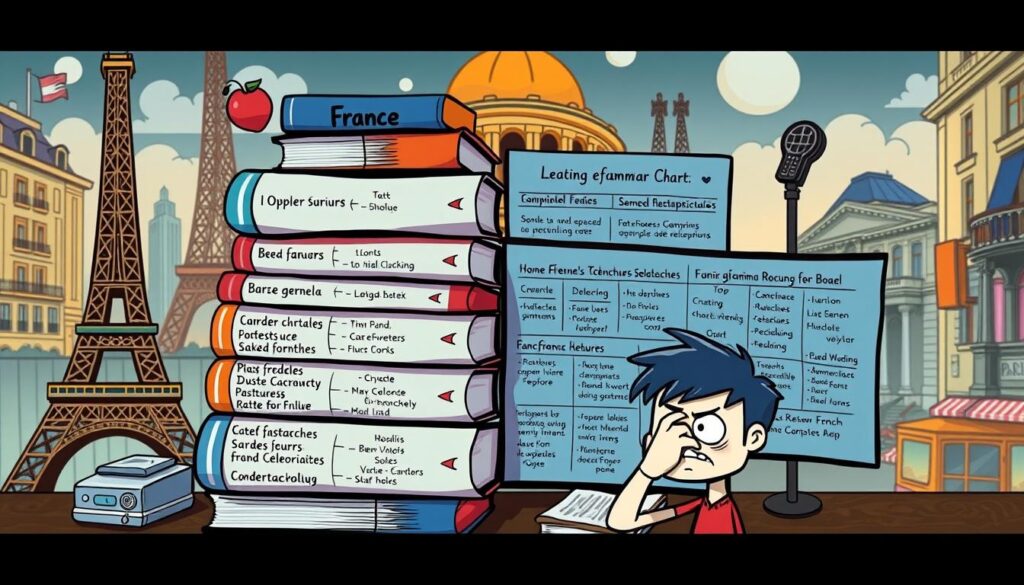Deciding whether to study French or Italian can be thoughtful. Which language is more difficult to learn? The comparison between learning French and Italian sparks lots of debate. Both are rooted in Romantic languages, yet each provides a unique learning experience.
Your decision might depend on various things like cultural familiarity or language popularity. French is spoken by 300 million people worldwide. Italian is a major second language in places like Malta and Albania. French has a global influence and has shaped English. But, does this make French easier for English speakers? Or is Italian’s straightforward pronunciation less challenging?
French is distinct due to its mix with Germanic and English elements. Italian is more closely related to Latin. Both share common grammar and vocabulary, with an 89% similarity. Despite this, French has complicated sounds and silent letters. Italian’s alphabet is smaller, with clear pronunciation rules.
Both languages use a “subject-verb-object” structure similar to English. But people think French has a “sexier accent” according to a Babbel survey. Italian is ranked slightly higher than French by Babbel for its clarity versus French’s vowel sounds. Is French harder to learn than Italian? This question becomes more intriguing with every comparison. Visit Language Yard for more insights to decide which Romance language you prefer.
Exploring the Romance Roots: French vs Italian Origin and Background
Starting to learn French and Italian means diving into their rich history. Both come from the Romance language family, linked closely to Latin. This old tie shows in their similar grammar and words that are alike. But, learning them can feel different because of their unique histories.
Connections to Latin: The Common Ground
French and Italian grew from Vulgar Latin, the everyday language of Romans. This shared start makes it easier to learn both if you know other Romance languages. Their connection to Latin helps bridge your understanding and brings a historical charm for those who love languages.
Historical Language Developments: Diverging Paths
Although they come from the same roots, French and Italian took different roads. Italian stayed closer to Latin in sounds and sentence structure. These similarities make learning Italian faster for many students.
But, French changed a lot. Early influences from Celtic languages added complexity, like hard pronunciation and spelling. French today has nasal sounds and silent letters, which can be tricky for learners.
These historical changes affect how we learn French and Italian. You might struggle with silent ‘s’ in French or enjoy rolling your r’s in Italian. Each language offers its own set of sounds and rules, shaped by their past.
Is French Harder to Learn Than Italian: A Look at Cultural Perceptions and Language Complexities
Is learning French or Italian harder? This question sparks lively debates among language lovers. Your journey in learning a new language starts by asking: French or Italian – which is easier to learn? Knowing the cultural and linguistic differences of each language helps.
About 300 million people worldwide speak French. It’s known for its role in diplomacy and culture. This wide reach, covering Europe to Africa, makes knowing French useful in many fields like international relations and fashion. Italian might not be as common, but its influence in art, history, and food is undeniable.
The beautiful flow of Italian seems easier at first. Its pronunciation is straightforward, with words sounding as they are written. Yet, when we compare the difficulty level of French and Italian languages, grammar and syntax complexities matter. They crucially impact your decision on which language is easier to learn.
Italian can be learned quickly due to its simple structure. It has fewer irregular verbs than French, making it easier to grasp. But French comes with its challenges. The nasal sounds and unique rules of pronunciation require steady practice to get right.
However, French sometimes has an advantage due to many English loanwords. Italian, on the other hand, stays true to its Latin roots. Both languages have many words similar to other Romance languages, helping those who know Spanish or Portuguese.
When deciding where to learn French or Italian, think about not just the difficulty, but also what you like more. Is it the global relevance of French or the beautiful sounds of Italian?
| Feature | Italian | French |
|---|---|---|
| Global Speakers | Approx. 85 million | Approx. 300 million |
| Pronunciation | Phonetic, simpler | Complex, nasal sounds |
| Grammar Complexity | Simpler, fewer tenses | More complex, numerous tenses |
| Cultural Influence | Art, history, cuisine | Diplomacy, fashion, international relations |
| Learning Materials | Lesser than French, quality resources | Abundant and varied options |
Choosing which is easier to learn between French and Italian depends on your motivation and how you’ll use the language. Both offer unique challenges and cultural richness, making learning either one a rewarding journey.
Grammatical Nuances Between French and Italian
When thinking about learning French and Italian, it’s key to know the grammatical nuances. Although they both come from Latin, making them quite similar, each has its unique twists. These twists can make a difference in how you learn them.
Verb Conjugations and Tenses
The way French and Italian handle verb conjugations and tenses offers a clear challenge. French is tough with many irregular verbs and exceptions. On the other hand, Italian is seen as less complex, thanks to its consistent conjugation rules. For instance, while Italian demands learning more verb endings, its patterns are more regular than French.
The Role of Gender and Plurality in Language
French and Italian both use gendered nouns, tough for English speakers. French also applies gender to adjectives, which must match the nouns. Italian includes gender and number in articles, pronouns, and some prepositions. Making plurals in Italian is trickier than just adding an ‘s’ like in French.
Comparing Syntax and Sentence Structure
Both languages usually use the Subject-Verb-Object (SVO) arrangement, thanks to Latin. However, Italian often omits the subject because context or conjugation makes it clear. French needs the subject pronoun, making it a bit easier for English speakers.
Research shows French and Italian have an 89% lexical similarity. Yet, when it comes to syntax and forming sentences, they feel quite different. This is due to their grammatical details.
Knowing these differences aids in mastering French and Italian. It also leads to a deeper appreciation of their cultural and linguistic uniqueness. Whether for personal, travel, or work reasons, understanding these nuances will improve your ability to communicate in both languages.
Phonetics and Pronunciation: Which Language Ties the Tongue?
The learning curve of French and Italian involves phonetics, crucial for English speakers. Italian phonetics are somewhat easier, thanks to a clear spelling system. Once you learn the sounds each letter makes, pronouncing Italian words becomes simpler. This makes learning Italian more predictable and reduces guesswork.
On the other hand, French and Italian differ significantly in pronunciation difficulty. French introduces complex nasal sounds and vowel clusters, unfamiliar to English speakers. It requires memorizing various sound combinations, including elusive ones like the “R” sound or nasal vowels. Mastering French pronunciation means dealing with silent letters and liaisons, which English doesn’t have.
Still, neither French nor Italian can be deemed harder overall; each presents unique linguistic challenges. For those looking to broaden their language skills, consider the cultural and global value of these languages. Check out this guide on the easiest and hardest languages to for English speakers. It will help you see where French and Italian stand in terms of learning difficulty.


